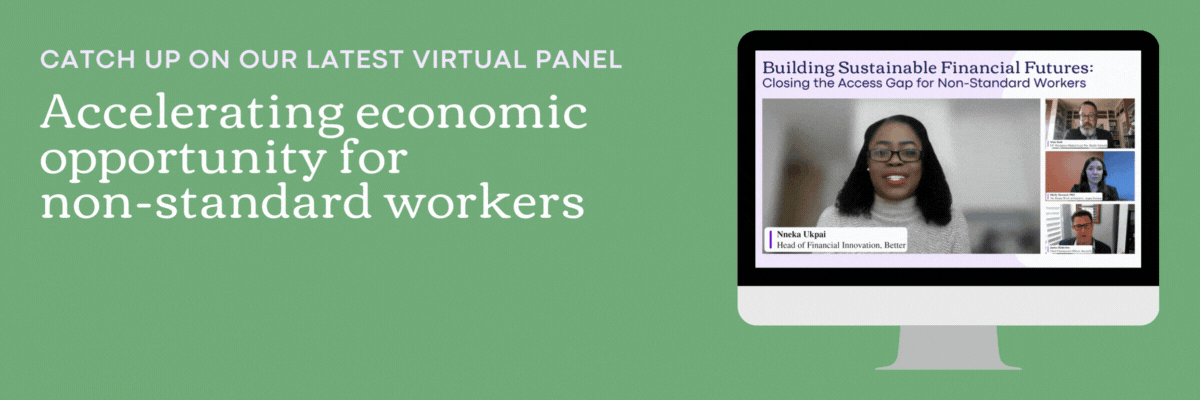3 Key Takeaways about the Future of Non-Standard Work
There’s no shortage of data confirming that “non-standard” work has increased in recent years. The pandemic saw a particular expansion in this kind of work, as many lost their full-time, W-2 jobs. When you add in historic inflation, there is an even greater need to take on this kind of gig work to close the gap between income and expenses. Evidence suggests that these increases are here to stay, with current projections that at least 50% of all American workers will earn some type of 1099 income by 2025.
Gig work is growing - what will the future look like?

With such an increase in the percentage of these workers, what does the future of work look like for this group? We recently addressed this in the closing of our live panel: Building Sustainable Financial Futures: Closing the Access Gap for Non-Standard Workers. The discussion was hosted by our own James Haberlen, Chief Commercial Officer at SteadyIQ, and featured Matt Bahl (VP, Workplace Market Lead at Financial Health Network) Shelly Steward (Director, Future of Work Initiative at Aspen Institute Economic Opportunities Program), and Nneka Ukpai (Head of Financial Innovation at Better).
Watch the full conversation here.
3 Key Takeaways about the Future of Non-Standard Work
1. “Non-standard” work shouldn’t be considered other.
Shelly Steward of the Aspen Institute was quick to point out that “non-standard workforce” is really a catch-all term for anything that isn’t W-2 employment.
“Non-standard work is not one type of work or one type of job. And it includes actually an incredibly broad range of different work experiences. So it's defined against a specific model—that long-term, full-time, direct hire W-2 employment,” Steward said. “It's important to highlight the diversity of experiences, types of work, and therefore challenges, when we're talking about this really heterogeneous workforce.”
One of the main challenges for this workforce is the lack of protections that guarantee benefits. “If we work toward universal protections, and universal benefits that all workers can access, we don't need that ‘non-standard’ designation,” Steward said.
“We don't need to see it as non-standard, as other, as different. We may see more and more different ways of working, including ones we haven't even imagined. But ideally, we don't want to see those as ‘non-standard.’ They should be like all ways of working and provide a decent standard of living, dignity, and pathways to a brighter future. So I don't want there to be more non-standard work, I want there to be more good work.”
2. Non-standard work is the future of work.
Nneka Ukpai of Better believes that older generations may be in denial that Americans today do not want to return to traditional W-2 full-time jobs, but the Great Resignation is proving otherwise. “Younger millennials, Gen Z, they're non-conformist,” she said. “It’s happening very proudly across LinkedIn, with younger people turning intentionally, to more gig work, more freelance work, and taking control over their time and their lives.”
The accessibility, low barriers to entry, and flexibility of “1099” work does allow for an increase in overall participation in the workforce, which is significant. On the flip side, it also means more people will face issues accessing the financial products they need if our financial systems do not account for this kind of work.
“I think that financial institutions who are willing to lean into [the increase in the non-standard workforce] and embrace it, and provide access earlier than other financial institutions, they're going to engender loyalty and win the future,” Ukpai said.
3. We need to move quickly, nimbly, and agilely.
The future is already here, Matt Bahl of the Financial Health Network said.
“We're really trying to build the plane while flying it,” he said. “So we really need to be thinking about more agile, nimble experimentation in new ways. And while I certainly think policy has to play a major role in that, I don't think nimble and agile are the first words that come to mind when we think about policymakers.”
As a result, Bahl called on the collaboration between the public and private sectors as key, stressing we can’t put it off. “We're in the future, it's here. And so we need to move quickly, we need to move nimbly, we need to agilely. And that's going to require a really big cross-section of stakeholders to bring that to life.”
For even more insights from our panelists, be sure to watch the full video by clicking the button below.

